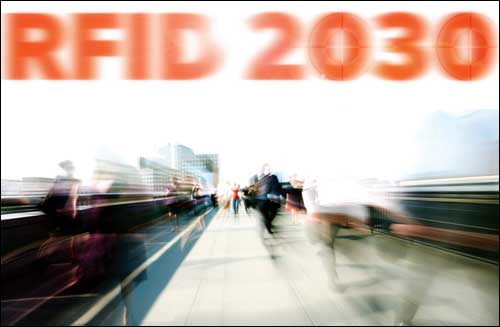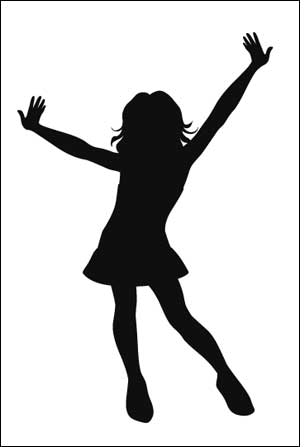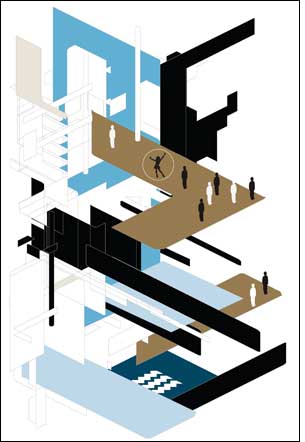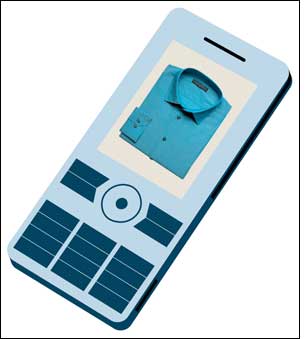All CEOs wish they had a crystal ball, so they could see the future and prepare for it rather than simply react to change. Unfortunately, there’s no way to know what the world will be like in, say, 20 years. But we believe radio frequency identification will be widely adopted by 2030 and will have a profound impact not just on the way companies do business, but on the way people shop, travel, learn and more.
Exactly how this growth will take place isn’t clear, but there are signs. Technology providers that promote the benefits of RFID and deliver solutions to solve specific business problems, providing a fast return on investment, will lead the way. At the same time, companies that use the technology—to track assets and inventory, streamline operations and business processes, or provide customer services—will create and leverage an RFID infrastructure to achieve even more benefits.
|
|
In the scenarios on the following pages, we imagine what the world will be like in 2030. Read them, then ask yourself where your company will be 20 years from today. Will you be powering or using the solutions that attract shoppers to retail stores, expedite product shipments, put the joy back in travel, enhance education, simplify chores and save lives? Or will you be playing catch-up?
* * *
It was one of those crisp fall Saturday mornings in New England when the leaves show off their changing colors and you can finally appreciate the quiet of the neighbors not mowing their lawns. Rob Caldwell, stuck indoors working on a budget report due first thing Monday, looked up when his 6-year-old daughter, Mandy, came bounding into his home office.
“Daddy!” He knew immediately what she wanted. “Can we go to the mall? Can we?”
“I have a lot of work to do, sweetheart.”
“But Kids’ Heaven has Dinosaurs Live, and Jill needs to get her cell phone fixed.”
“Dinosaurs Live? That sounds scary.”
“It’s so cool, and it’s educational,” Mandy assured him. “The dinosaurs roar when they find another dinosaur they want to eat, and they turn and run when they see something dangerous like fire.”
“I don’t know if I want you playing near fire.”
“It’s an interactive game. And Mom promised me. For my birthday.”
“All right,” he said. “Round up the gang.”
Mandy skipped out of the room, hooting and howling for the rest of the family to get ready. Rob resigned himself to finishing his report after everyone had gone to bed.
The mall was only about five miles from the Caldwell home. As the family pulled up to the entry of the three-story parking garage, an interrogator near the gate read the tag on the car’s windshield. “Good morning, Mr. Caldwell,” said an excessively solicitous voice from the speaker. “There are plenty of parking spaces on the top floor. There is also one near the crosswalk on Level 2.”
“How do they do that?” asked Jill, age 10, who was president of her school’s Robotics Club.
“RFID sensors in each space,” Rob replied. “The sensor sends out an infrared signal, and if the light bounces back, it indicates a car is parked there. That information, along with a unique ID number associated with that space, is sent wirelessly to a reader, which lets the software my company makes know that Space 123 is full. The spaces that are empty are communicated to people entering the garage.”
As they pulled into the space on Level 2, Mandy, Jill and Reid, age 14, jumped out of the minivan and headed for the mall entrance. “Hey, hey, hey,” Rob yelled. “You forgot your wristbands.” He gave them each a yellow, plastic band with an active transponder. Each had a small screen made of electronic paper big enough to display a few words. “Check your wristband for messages,” Rob reminded them, and then they were gone.
His wife, Linda, had unbuckled Jeffrey from the car seat in the back, and they made their way to Fun Park, where the 2-year-old was given a toddler wristband (no screen, not removable by a child). They left him there to play while they did their errands.
“Hey, let’s go to Electro-Mart,” Linda said. “I need to return Jill’s cell phone and look for a new laptop for Reid.”
“You go,” Rob said. “I want to pick up some stuff for dinner.”
“OK, I’ll message you when I’m done.”
Linda went into Electro-Mart and headed straight to the service desk. There were three people in front of her, but the line moved quickly.
“How can I help you, ma’am?” asked the young man whose name badge said Jack.
“I bought this phone for my daughter, and she’s no longer able to download data from signs with it.”
“Can she still buy stuff with it?”
“Yes, yes.”
Jack waved the phone in front of the computer and called up all the information on it. “You bought it on Dec. 17 of last year, so it’s still under warranty,” he said. “This unit has a defective chip. We sent you an e-mail notice.”
“Oops, I forgot about that.”
“No problem. I’m going to give you a new, upgraded phone.” Within a minute, Jack had a new phone in Linda’s hands, and she was off to look at computers for Reid.
Meanwhile, Rob was in the grocery store, choosing some steaks. He placed two juicy sirloins on a kiosk. A screen popped up asking if he wanted to check the calories these items contained, get recipe recommendations or see a product history. He pressed History, and was informed that the animals had been raised on a certified organic farm in Iowa, and was shown where they’d been butchered, how long the meat had spent at a Chicago distribution center, and at what temperatures it had been stored. One of the steaks had reached a temperature close to the FDA-allowable high, so he replaced it with another.
Rob tossed the steaks into his cart. The price for each, including tax, appeared on the cart’s screen.
Since it was his turn to cook, he checked the recipe recommendations on the kiosk. Spicy Lemon Pesto Steak sounded good, so he pressed Print. He clicked on the link for Lemon Pesto Sauce—two bottles left on the shelf—then on Directions. The screen indicated his position in the store and directed him to Aisle 14, where he grabbed a bottle.
Rob checked his cell phone, replied to Linda’s text by agreeing that a 40-terabyte hard drive was big enough for Reid, then called up his shopping list and transferred it via Bluetooth to the screen on the cart. The screen showed him the fastest route to the remaining items on the list.
Rob tossed a box of Corn Flakes in the cart; the price total updated automatically and a green light flashed on the screen, indicating the item had not passed its sell-by date. He spotted a new flavor of Captain Crunch. Mandy loved Captain Crunch, but she was allergic to nuts. Rob waved his cell phone over the box to capture the ID, then pressed More Information. The ingredients, sell-by date and price appeared on his phone. No nuts. The application on his phone then asked if he wanted the product history, comparative prices at other stores nearby, similar products and recipes using the product. He pressed No and slipped his phone back into his shirt pocket.
On his way toward the exit, a special offer for Bud Gold popped up on the cart’s screen. Rob pulled out his cell phone, clicked on the refrigerator icon and pressed Retrieve. Only three bottles of beer left, so he slipped down the beer aisle. He clicked on the Bud Gold offer. “Rob, we’re having a special, just for you. Buy two cases and save 20 percent.”
Rob put two cases in the cart, clicked on Finished Shopping, confirmed his total and pressed Checkout. Then he dropped the food off in the car and went to a kiosk to locate Linda and his daughters. The kiosk showed the girls had left Kids’ Heaven and were headed toward the Interactive Store. He bet Jill wanted to see the new MoodBelts, which have a built-in RFID reader that can identify someone you meet, check their public Facebook page and change colors based on whether you share similar interests—green if you have hobbies in common, yellow if you like similar books and red if you’re likely to be attracted to one another romantically. Rob hated the idea, especially for a girl as young as Jill, so he decided to intercept them. He typed “coming 4 u, stay at Kids’ Heaven” on the kiosk keyboard. The girls’ wristbands would beep, alerting them to the message.
Reid was at McCool’s shopping for clothes. Rob and Linda preferred Apparel-Mart, which offered the largest selection of basics of any store in the world and had made a name for itself early on by using RFID to guarantee it always had the items you wanted in the right colors and sizes. That had earned Rob’s and Linda’s loyalty. They remembered the days when you had to schlep from store to store to buy clothing and shoes. Their kids took well-stocked stores, among other things, for granted.
When Reid got to McCool’s, he used his iPhone to find the items he had bookmarked online. He was standing in front of a mirror, chatting with his girlfriend, Barbara, through a phone built into the mirror. She was watching him model a pair of jeans and a shirt on her phone. “I like the fit,” she said, “but the shirt doesn’t work with those jeans. Rob dragged his finger across a photo of the shirt on the mirror, calling up all the other styles they had. He selected “teal” and “rust” and hit send. “Teal,” Barbara said. “Call me when you get home.”
Reid tried on a few other items, but wasn’t sure. He sent Barbara images he took of himself in the dressing room, but she didn’t respond, so he pressed Save on the screen, entered his password and stored the items on his personal page on the McCool’s Web site. The system saved the images and the size, color and style of each item, so he could purchase them online when he got home.
With the teal shirt and jeans in a bag, Reid went up to a kiosk, waved his credit card and headed toward the exit. His wristband had alerted him to meet the family at Charlie’s in the food court. When Reid got there, Linda had already picked up Jeffrey, and Rob was waiting with Jill and Mandy.
“Let’s get some lunch before we head home,” Rob said. As they entered the restaurant, a sign said, “Welcome to Charlie’s. It will be approximately three minutes until the next table is available.”
“When I was a kid…” Rob said, but he was quickly interrupted.
“We know, Dad,” Mandy said. “They couldn’t tell you how long you had to wait for a table.”
“And you couldn’t get any information on the products you wanted to buy,” Reid added.
“And you got lost in the mall,” Jill chimed in.
“OK, OK, ” Rob said smiling, recalling similar conversations he’d had with his parents. “I guess some things never change.”
Photos and illustrations: iStock Photo. Cover photo: René Mansi/iStock Photo
* * *
We’d like to thank the following people for sharing their insight and expertise to help us look into RFID’s future:
• Magda Balazinska, assistant professor, department of computer science and engineering, University of Washington
• Venkat Krishnamurthy, CTO, Checkpoint Systems
• Michael Liard, RFID practice director, ABI Research
• Mike Liebhold, senior researcher, Institute for the Future
• June Ruby, director of manufacturing solutions group, Motorola Enterprise Mobility Solutions
• Alan Sherman, director of marketing, OATSystems
• Chris Warner, senior product manager of RFID, Motorola Enterprise Mobility Solutions
To read more RFID scenarios from the year 2030, click here.





